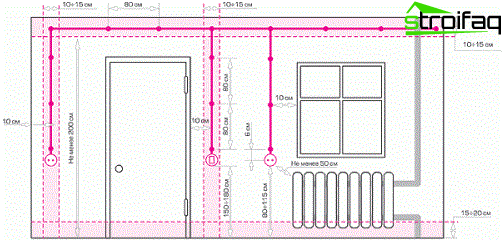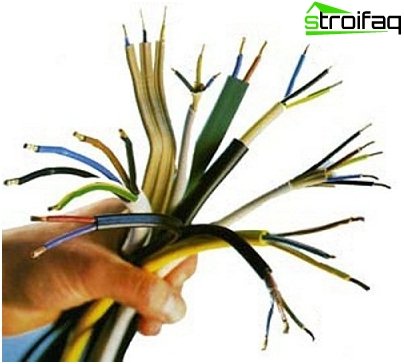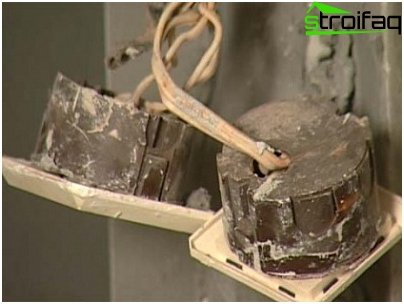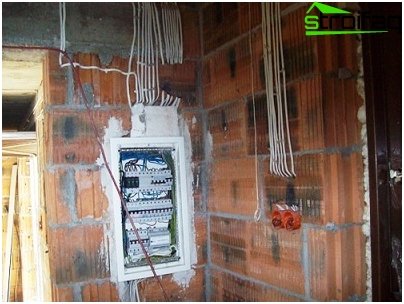Calculation of electrical wiring in an apartment and a house
From the school physics course: “The movement of charged particles leads to heating of the conductor.” Most likely, this axiom is also known to you, but did you know that the amount of heat generated during this movement depends not only on the intensity of the particles themselves (current strength), but also on the cross section of the conductor. If the wiring in the house operates in normal mode, then excess heat is simply dissipated into the surrounding space, without adversely affecting the electromechanical characteristics of the cables or the quality of the power supply. And if the calculation of the electrical wiring was made incorrectly, then in the first days of its operation, you can detect a violation of the integrity of the conductive conductors and the insulation layer. This happens due to the banal overheating, which was caused by your own hindsight.
Content
- How many wires are needed?
- Competent calculation of wiring
- Do I need power headroom
- A little about protection and “accessories”
How many wires are needed?
There are always few wires – every electrician knows this. That is why in a suitcase from a professional installer you can find more than one skein of this important material.
To begin with, if you yourself have undertaken the installation of wiring, you need to measure and calculate everything. To do this, you will need ordinary roulette. Consider all angles, protrusions and niches, calculate the number of electrical appliances that you and your household will use and multiply the total figure by 15%. This is a standard stock during technical calculations..

Sample wiring plan
If you want to run with a tape measure in a three-story cottage or apartment of 300 square meters. you don’t have meters, but you still need to know at least an approximate figure, you can use a simple approximation: multiply the total area of all residential and non-residential premises in square meters by 2. For example, your apartment has an area of 72 square meters. m, which means you will need to buy about 150 meters of electric cable. Scary figure? Not at all! Now, if a designer comes in, gushing with creative ideas, then the total amount of your posting costs can really scare you. Spotlights, wall sconces, led strip, chandeliers – all this requires an insane amount of wires.
And if you need more than one type of wire? Then take a chance and take it at a rate of 1: 2 – one part will go to apartment lighting, and the other two – for its power supply. For laying individual cables of “special purpose”, for example, to an electric stove, air conditioners, a washing machine, you will have to make accurate measurements, and for small household appliances you can buy an ordinary three-wire cable.

Types of wires and cables – the choice is huge
Competent calculation of wiring
Most often, doing calculation of wiring in the house, electricians offer to buy three-wire wires or cables with aluminum or copper cores enclosed in polyvinyl chloride insulation. Such materials are ideal for concealed wiring – they do not heat up and can last for decades. For an open installation method, these wires and cables are also suitable, however, this method is currently practically not used, except in the case when it is impossible to recess the wall.

Old wiring is a source of increased danger
In the table you will find data on the type of wire and its maximum current strength and use this information in your calculations.

Table of calculation of cable cross-section depending on the load
And now in more detail. As you can see, the throughput of electrical wiring is determined not in kilowatts, but in amperes. However, when it comes to calculating the wiring for connecting a section of a circuit or some device, it will be necessary to build on power, that is, on kilowatts. This relationship can be expressed by the following formula:
P = U ∙ I ∙ cosφ
where P is the connected power of the device (W), U is the voltage (V), and cosφ is taken as a unit if the electrical wiring in the apartment is calculated for large areas, or in general it is omitted if the apartment or house is modest in size.
Further. We express the current strength as the ratio of the connected power to the voltage by the formula:
I = P / U .
For example, let’s calculate the current strength in a single-phase circuit with 10 standard incandescent lamps connected to it, 100 watts each, with one microwave oven with a power of 1 kW and a 2-kilowatt electric kettle.
The total power of all devices: 10×100 + 1000 + 2000 = 4000 watts. The voltage in the network is 220 V (take the reference figure). Dividing the power by the voltage, we get 18.18 A. That is, in the calculated area of the electric circuit, the current strength is 18.18 A. And now look at the table and determine for yourself which type of wire is most suitable.
Thus, the calculation of the cross-section of the wiring is quite simple, if, of course, you have at least the slightest idea of the school physics course and know a few useful formulas.
Do I need power headroom
Of course, the margin of power when installing wiring should be taken into account, but do not go crazy – everything should be within reasonable limits. Some electricians, in order to cash in on ignorant homeowners, offer the latter to buy a cable with a cross section of 6 mm2 for an ordinary room (children’s or bedroom), while the input cable of the entire house or apartment has a cross section of 4 mm2. Recklessness – you cannot call it otherwise! Electricians simply explain such thrifty: the more devices in the house, the more cable is needed. However, this power reserve is not needed at all – it will only lead to additional costs for the purchase of cables and their installation.
Reasonable procurement minimizes your financial costs, and without any damage to safety and reliability. A correctly performed calculation of the wiring power will save your money, while the electromechanical characteristics of the conductive wires will not be affected. And this applies not only to the cross-section of wires, but also to the structure of the line. A single-line wiring diagram will reduce the length of the cables, which means that both installation time and material costs will decrease.
A little about protection and “accessories”
We figured out the wires a bit, but what about residual current circuit breakers, switches, sockets? How many do they need?
Residual current circuit breakers instantly shut off the network if a leak is detected in excess of the rated value. Such a miniature appliance must be installed for powerful appliances such as water heaters and washing machines. In addition, to protect the entire network, you need to use circuit breakers that instantly respond to short circuits or overloads and disconnect the network from power.
As a result. For a typical city apartment you will need: a copper or aluminum cable with a cross section of 1.5 mm2, designed for a current of 16 A (the figure may be different, depending on your home), a cable with a cross section of 2.5 mm2 for outlets, designed for a current 25 A, circuit breaker – 10 A and 16 A. You can find out the power consumption of electrical appliances from the technical data sheet.

Final wiring (before finishing work)
In addition to everything that you just read, there are many other aspects, such as the correction factor of the ambient temperature, the coefficient for jointly installed devices, and so on, which must be taken into account when calculating the electrical wiring. Therefore, for your own peace of mind, contact specialists, especially in the case when energy-intensive appliances and powerful power receivers with reactive load will be used in your apartment. The project of full power supply of your home, they will calculate without any problems, you just have to bring it to life.






